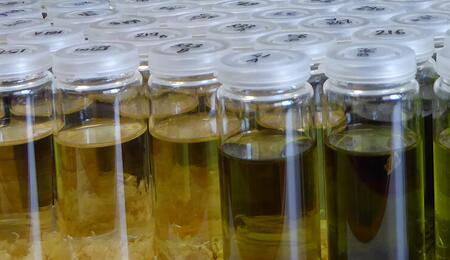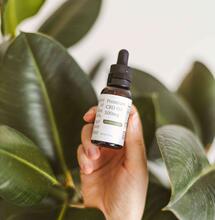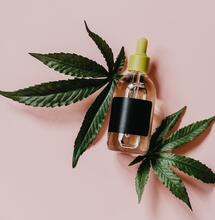CBD Testing and Breeding 2.0

.
We visited Dinafem and talked with Dr. Ananda, who told us about how it uses lab tests to develop its CBD strains.
The Dinafem lab was founded 4 years ago. It started in October 2012, with a team of specialists working in association with Renovatio and Ai Laket. The lab room was originally meant for a risk mitigation project consisting of the analysis of samples supplied from clubs - to which information on cannabinoid content was then returned.
Dinafem actively supported the project and further developed its testing activity to breed autos and further study their strains. It started from scratch because the then applied analytical method was incorrect and it had to design and validate its own method. Requirements have grown since the days of early tests, and it managed to achieve a reliable degree of test precision. As Dr. Ananda explained to me, “when we receive new testing instruments, the embedded software is somewhat blind, which means you need to add you own validated processing method”.
[caption id="attachment_4910" align="alignnone" width="500"] Parent selection[/caption]
Parent selection[/caption]
 Plants with hermaphrodite traits are discarded[/caption]
The other aspect that it emphasised is the importance of the growing method and of the grower, as different cannabinoid levels can be obtained from the same plant. In particular, it could demonstrate that, in a climatically controlled environment, with higher light intensity, a grower can obtain abundant yields and higher resin and cannabinoid levels. Similarly, depending on the ability of a grower, CBD levels can increase or decrease within a given range.
Plants with hermaphrodite traits are discarded[/caption]
The other aspect that it emphasised is the importance of the growing method and of the grower, as different cannabinoid levels can be obtained from the same plant. In particular, it could demonstrate that, in a climatically controlled environment, with higher light intensity, a grower can obtain abundant yields and higher resin and cannabinoid levels. Similarly, depending on the ability of a grower, CBD levels can increase or decrease within a given range.
 CBD-dominant male full of pollen[/caption]
Before initiating the project, it knew the theoretical basics of breeding – especially CBD breeding. But as it moved through various steps, it shifted from theory to practice, and demonstrated, with a reliable instrument such as the chromatograph, that it was achieving the desired results.
Since it only worked with the chemotypes needed in that project, it could make several selections, with the opportunity to discard a large number of individuals and use only the best. Its first task was to separate the chemotypes of CBD dominant plants, with concentrations varying from plant to plant. In that process, it selected plants with the highest cannabinoid levels. In the common practice, tests are obviously only one part of the story; occasionally a lab test finds chemotypes that are apparently very similar and differences emerge only when you go back to cultivation. For this very reason, analytical data count together with the human factor; the work of expert breeders is what gives the final selection a special Dinafem touch.
After analysing full populations, its next step was to draw charts showing distribution. This is particularly useful in order to start working with concrete genetic materials and assess whether plants behave as desired. Normally, this mapping is also used to discard any plant groups with no interest for the project. Currently, this step has become superfluous, as the Dinafem staff are perfectly knowledgeable of the genetic materials they are working with and know beforehand what will be needed in crosses, so they directly aim at the desired result.
After gaining experience in various testing phases, the bank acknowledged that a plant cannot be completely judged until its ripeness, but not all phenotypes ripen in the same span of time, which makes comparisons incorrect. Indeed, at day 30 the best individual in a group can merely be an early grower, while at day 60 it cannot necessarily be the best in the same group.
It also told us about its experience in testing the ratios of various extracts – i.e. checking effects on various patients to define those associated with each ratio. It said it had also analysed various CBD extracts made from industrial hemp available on the market, and discovered that some of them are law-quality products and had much lower contents than those shown on the label.
CBD-dominant male full of pollen[/caption]
Before initiating the project, it knew the theoretical basics of breeding – especially CBD breeding. But as it moved through various steps, it shifted from theory to practice, and demonstrated, with a reliable instrument such as the chromatograph, that it was achieving the desired results.
Since it only worked with the chemotypes needed in that project, it could make several selections, with the opportunity to discard a large number of individuals and use only the best. Its first task was to separate the chemotypes of CBD dominant plants, with concentrations varying from plant to plant. In that process, it selected plants with the highest cannabinoid levels. In the common practice, tests are obviously only one part of the story; occasionally a lab test finds chemotypes that are apparently very similar and differences emerge only when you go back to cultivation. For this very reason, analytical data count together with the human factor; the work of expert breeders is what gives the final selection a special Dinafem touch.
After analysing full populations, its next step was to draw charts showing distribution. This is particularly useful in order to start working with concrete genetic materials and assess whether plants behave as desired. Normally, this mapping is also used to discard any plant groups with no interest for the project. Currently, this step has become superfluous, as the Dinafem staff are perfectly knowledgeable of the genetic materials they are working with and know beforehand what will be needed in crosses, so they directly aim at the desired result.
After gaining experience in various testing phases, the bank acknowledged that a plant cannot be completely judged until its ripeness, but not all phenotypes ripen in the same span of time, which makes comparisons incorrect. Indeed, at day 30 the best individual in a group can merely be an early grower, while at day 60 it cannot necessarily be the best in the same group.
It also told us about its experience in testing the ratios of various extracts – i.e. checking effects on various patients to define those associated with each ratio. It said it had also analysed various CBD extracts made from industrial hemp available on the market, and discovered that some of them are law-quality products and had much lower contents than those shown on the label.
 Male sampling[/caption]
As Dr. Ananda remarked, “in order to achieve specific results, it is crucial to follow best practices ever since the beginning, when you take samples and throughout the testing process”. In my visit I clearly understood what he meant – before starting, they put on a white gown and latex gloves. First, they selected the most interesting plants and numbered them; next, they took samples without touching flowers and placed them directly into jars, which were in turn numbered both on the side and on each cap to reduce the possibility of errors.
Testing was the next step; here Dr. Ananda follows a specific method, which was described in our article “Pollination day”. In the meantime, however, this method has been improved through the use of lower temperatures and fewer materials (to avoid soiling the chromatograph). To make a long story short, the process involves drying the sample at 40º, weighing it, dissolving it with ultrasounds, centrifuging it, treating it in the oven for decarboxylation, diluting it in ethanol and placing it in the chromatographic column. Each analysis is repeated several times to exclude errors. Finally, Dr. Ananda interprets results at the PC and prepares reports for each population group.
Male sampling[/caption]
As Dr. Ananda remarked, “in order to achieve specific results, it is crucial to follow best practices ever since the beginning, when you take samples and throughout the testing process”. In my visit I clearly understood what he meant – before starting, they put on a white gown and latex gloves. First, they selected the most interesting plants and numbered them; next, they took samples without touching flowers and placed them directly into jars, which were in turn numbered both on the side and on each cap to reduce the possibility of errors.
Testing was the next step; here Dr. Ananda follows a specific method, which was described in our article “Pollination day”. In the meantime, however, this method has been improved through the use of lower temperatures and fewer materials (to avoid soiling the chromatograph). To make a long story short, the process involves drying the sample at 40º, weighing it, dissolving it with ultrasounds, centrifuging it, treating it in the oven for decarboxylation, diluting it in ethanol and placing it in the chromatographic column. Each analysis is repeated several times to exclude errors. Finally, Dr. Ananda interprets results at the PC and prepares reports for each population group.
 Each jar is numbered twice[/caption]
Each jar is numbered twice[/caption]
 Parent selection[/caption]
Parent selection[/caption]
Advantages of tests
It soon demonstrated that breeding and selection aided by chromatography ultimately improves genetics. For instance, in 3 generations it saw that autos originally with 10% THC content rose to 15% or more. When these results were confirmed, Dinafem decided it needed more equipment of its own to increase the number and frequency of tests. So it started up this lab in September 2014 and, in January 2015, it was already completed. After the experience made with the previously used instruments, Dr. Ananda found it easier to prepare and validate that method, although with any new materials “you always need to run a few tests until you reach the desired level of precision”. Currently it considers these tests very reliable for its purposes and selections made so far have never produced results that were not expected. Initially, it went on with auto breeding and developed Bubba Kush Autoflowering and OG Kush Autoflowering. With these lines, results were without fail; from its initial crossing it developed interesting phenotypes that invariably proved to be successful – e.g. in the latest Expogrow cup, OG Kush Autoflowering was found to be the most potent contestant, with 20% potency exceeded after a test made by an independent laboratory. As Dr. Ananda pointed out, “testing plants permanently and consistently contributes a lot to line improvement, as you can easily identify the best specimens”. In addition to cannabinoid levels, tests also contribute to a better understanding of genetics. For instance, the distribution of the chemotypes of a given strain helps determine the starting material type, i.e. whether it is an F1, an F2 or an F3. [caption id="attachment_4911" align="alignnone" width="500"] Plants with hermaphrodite traits are discarded[/caption]
The other aspect that it emphasised is the importance of the growing method and of the grower, as different cannabinoid levels can be obtained from the same plant. In particular, it could demonstrate that, in a climatically controlled environment, with higher light intensity, a grower can obtain abundant yields and higher resin and cannabinoid levels. Similarly, depending on the ability of a grower, CBD levels can increase or decrease within a given range.
Plants with hermaphrodite traits are discarded[/caption]
The other aspect that it emphasised is the importance of the growing method and of the grower, as different cannabinoid levels can be obtained from the same plant. In particular, it could demonstrate that, in a climatically controlled environment, with higher light intensity, a grower can obtain abundant yields and higher resin and cannabinoid levels. Similarly, depending on the ability of a grower, CBD levels can increase or decrease within a given range.
CBD breeding aided by chromatography
Initially it focused on THC. For CBD it had much interest, but it barely reached appreciable levels. With routine analyses, it discovered a significant CBD level in one of the US genetic lines it was working with, from which it created Purple Orange CBD. Of course, it was perfectly aware that, in addition to THC and CBD, other cannabinoids had to be considered and were prepared to detect them in the event of unusual levels. Indeed, its purpose has always been to improve the global genetic pool. Moreover it told us that, over the last few years, it had made important discoveries worthy of interest and, in the near future, many more special plants would be put on the market. The next years will also be characterised by research on the “follow-up effect”, which consists of studying the impact of cannabinoid combinations (terpenes and other plant components) on the final effect. It is now common knowledge that results obtained with direct plant extracts are much richer than when a single cannabinoid is used. After gaining total confidence in its testing ability, it quickly proceeded with the CBD project, where it needed to use the best possible instruments that would undergo intensive use over several months. It even spent two full weeks making uninterrupted tests for the selection of the first parents over massive crops. Samples were prepared during the day while the machine analysed them at nighttime by means of an automated sample processor. In so doing, it saw that, despite the limited set of instruments, they were efficient enough to meet Dinafem’s requirements. As Dr. Kush puts it “there are seed banks using Dinafem’s OG Kush Autoflowering to produce good quality autos, so they take advantage of our work. But when it comes to CBD, there is a long way ahead of us and there are no shortcuts. Excellence can only be achieved through tests and long hard work, generation after generation”. [caption id="attachment_4912" align="alignnone" width="500"] CBD-dominant male full of pollen[/caption]
Before initiating the project, it knew the theoretical basics of breeding – especially CBD breeding. But as it moved through various steps, it shifted from theory to practice, and demonstrated, with a reliable instrument such as the chromatograph, that it was achieving the desired results.
Since it only worked with the chemotypes needed in that project, it could make several selections, with the opportunity to discard a large number of individuals and use only the best. Its first task was to separate the chemotypes of CBD dominant plants, with concentrations varying from plant to plant. In that process, it selected plants with the highest cannabinoid levels. In the common practice, tests are obviously only one part of the story; occasionally a lab test finds chemotypes that are apparently very similar and differences emerge only when you go back to cultivation. For this very reason, analytical data count together with the human factor; the work of expert breeders is what gives the final selection a special Dinafem touch.
After analysing full populations, its next step was to draw charts showing distribution. This is particularly useful in order to start working with concrete genetic materials and assess whether plants behave as desired. Normally, this mapping is also used to discard any plant groups with no interest for the project. Currently, this step has become superfluous, as the Dinafem staff are perfectly knowledgeable of the genetic materials they are working with and know beforehand what will be needed in crosses, so they directly aim at the desired result.
After gaining experience in various testing phases, the bank acknowledged that a plant cannot be completely judged until its ripeness, but not all phenotypes ripen in the same span of time, which makes comparisons incorrect. Indeed, at day 30 the best individual in a group can merely be an early grower, while at day 60 it cannot necessarily be the best in the same group.
It also told us about its experience in testing the ratios of various extracts – i.e. checking effects on various patients to define those associated with each ratio. It said it had also analysed various CBD extracts made from industrial hemp available on the market, and discovered that some of them are law-quality products and had much lower contents than those shown on the label.
CBD-dominant male full of pollen[/caption]
Before initiating the project, it knew the theoretical basics of breeding – especially CBD breeding. But as it moved through various steps, it shifted from theory to practice, and demonstrated, with a reliable instrument such as the chromatograph, that it was achieving the desired results.
Since it only worked with the chemotypes needed in that project, it could make several selections, with the opportunity to discard a large number of individuals and use only the best. Its first task was to separate the chemotypes of CBD dominant plants, with concentrations varying from plant to plant. In that process, it selected plants with the highest cannabinoid levels. In the common practice, tests are obviously only one part of the story; occasionally a lab test finds chemotypes that are apparently very similar and differences emerge only when you go back to cultivation. For this very reason, analytical data count together with the human factor; the work of expert breeders is what gives the final selection a special Dinafem touch.
After analysing full populations, its next step was to draw charts showing distribution. This is particularly useful in order to start working with concrete genetic materials and assess whether plants behave as desired. Normally, this mapping is also used to discard any plant groups with no interest for the project. Currently, this step has become superfluous, as the Dinafem staff are perfectly knowledgeable of the genetic materials they are working with and know beforehand what will be needed in crosses, so they directly aim at the desired result.
After gaining experience in various testing phases, the bank acknowledged that a plant cannot be completely judged until its ripeness, but not all phenotypes ripen in the same span of time, which makes comparisons incorrect. Indeed, at day 30 the best individual in a group can merely be an early grower, while at day 60 it cannot necessarily be the best in the same group.
It also told us about its experience in testing the ratios of various extracts – i.e. checking effects on various patients to define those associated with each ratio. It said it had also analysed various CBD extracts made from industrial hemp available on the market, and discovered that some of them are law-quality products and had much lower contents than those shown on the label.
Sampling, testing and selection
After talking in the lab with Dr. Ananda, I went – with him, Dr. Kush and Dr. O3 – to visit one of their plant selection areas. There I could see them in action while they made a careful selection among 250 females and 100 males. Firstly, they removed hermaphrodites, to prune intersexual traits out of the genetic pool. Most CBD plants presented Sativa traits but, as Dinafem is always looking for novelties, they ultimately privileged Indica traits and selected those with large leaves, a medium size and a delicious taste, and discarded plants tending towards a particularly large size – which may occasionally seem counter-intuitive. [caption id="attachment_4913" align="alignnone" width="500"] Male sampling[/caption]
As Dr. Ananda remarked, “in order to achieve specific results, it is crucial to follow best practices ever since the beginning, when you take samples and throughout the testing process”. In my visit I clearly understood what he meant – before starting, they put on a white gown and latex gloves. First, they selected the most interesting plants and numbered them; next, they took samples without touching flowers and placed them directly into jars, which were in turn numbered both on the side and on each cap to reduce the possibility of errors.
Testing was the next step; here Dr. Ananda follows a specific method, which was described in our article “Pollination day”. In the meantime, however, this method has been improved through the use of lower temperatures and fewer materials (to avoid soiling the chromatograph). To make a long story short, the process involves drying the sample at 40º, weighing it, dissolving it with ultrasounds, centrifuging it, treating it in the oven for decarboxylation, diluting it in ethanol and placing it in the chromatographic column. Each analysis is repeated several times to exclude errors. Finally, Dr. Ananda interprets results at the PC and prepares reports for each population group.
Male sampling[/caption]
As Dr. Ananda remarked, “in order to achieve specific results, it is crucial to follow best practices ever since the beginning, when you take samples and throughout the testing process”. In my visit I clearly understood what he meant – before starting, they put on a white gown and latex gloves. First, they selected the most interesting plants and numbered them; next, they took samples without touching flowers and placed them directly into jars, which were in turn numbered both on the side and on each cap to reduce the possibility of errors.
Testing was the next step; here Dr. Ananda follows a specific method, which was described in our article “Pollination day”. In the meantime, however, this method has been improved through the use of lower temperatures and fewer materials (to avoid soiling the chromatograph). To make a long story short, the process involves drying the sample at 40º, weighing it, dissolving it with ultrasounds, centrifuging it, treating it in the oven for decarboxylation, diluting it in ethanol and placing it in the chromatographic column. Each analysis is repeated several times to exclude errors. Finally, Dr. Ananda interprets results at the PC and prepares reports for each population group.
CBD-dominant parents
We also visited the area where it keeps the best CBD-dominant mothers, with which it creates its CBD hybrids. Instead of using the same CBD-dominant plant from different strains, which will homogenise them, Dinafem is one of the very few banks that keep a wide group of various CBD dominant parents, both males and females, in order to work on each hybrid independently. Although Dinafem continues working on and improving each line, this variety of parents places Dinafem among the leading banks active in CBD breeding. [caption id="attachment_4914" align="alignnone" width="500"] Each jar is numbered twice[/caption]
Each jar is numbered twice[/caption]
Conclusions
CBD strains are grown totally as a form of craftwork. In the past, breeders focused on a mix of intuition and luck. In those days, there were hardly any labs that could assist them. Currently, the human factor is complemented by extensive testing. This new breeding 2.0 is now progressing towards excellence more rapidly and growers will more and more benefit from a large variety of options – all different and totally stabilised. Text: H. Madera
S
Soft Secrets



